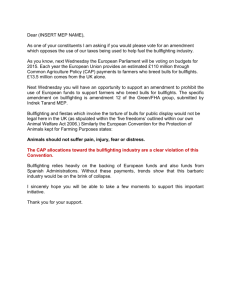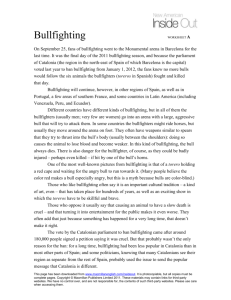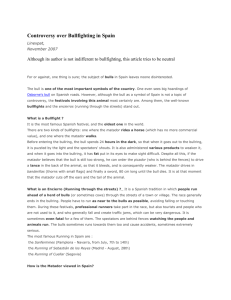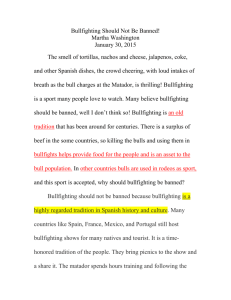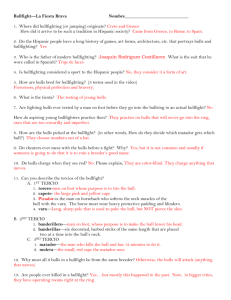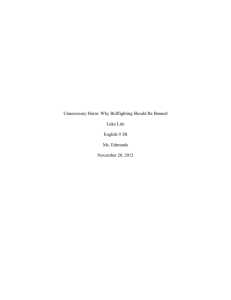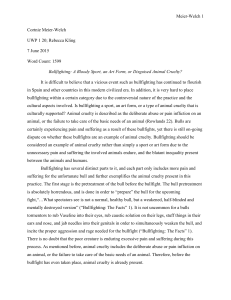Bullfighting
advertisement
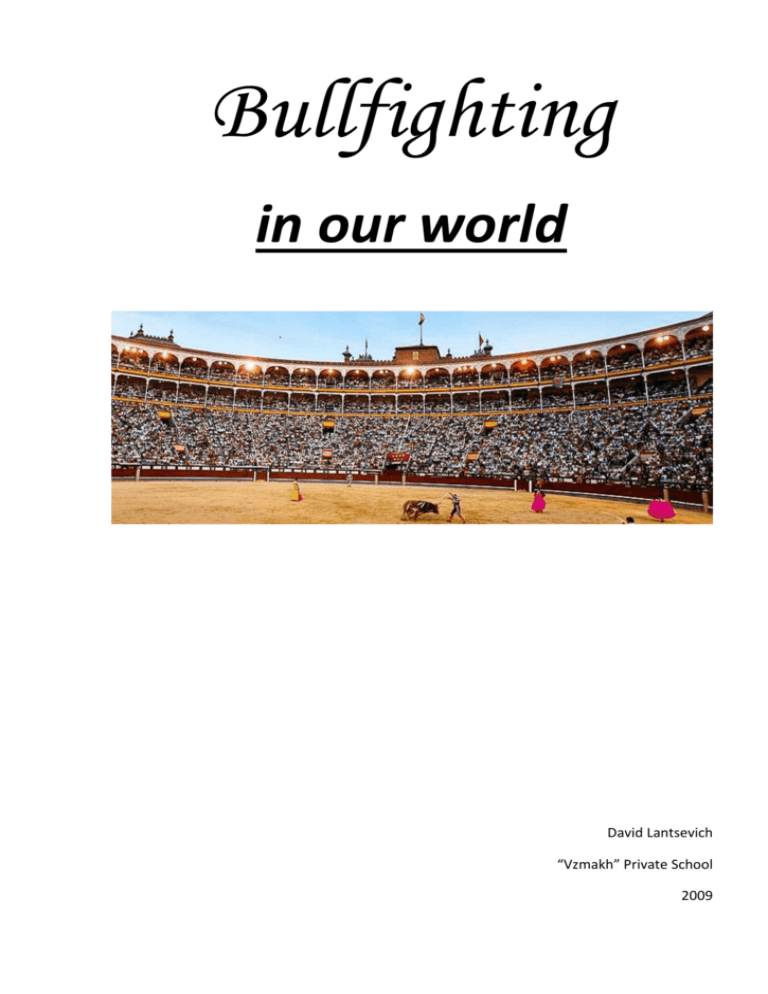
Bullfighting in our world David Lantsevich “Vzmakh” Private School 2009 Contents Introduction ..................................................................................................................................... 2 The history of bullfighting … .......................................................................................................... 3 - First bullfighting - Bullfighting in the Middle Bullfighting in many countries ........................................................................................................ 6 - Spanish style of bullfighting - Portuguese style of bullfighting - French style of bullfighting - Summary Popularity of modern bullfighting ................................................................................................. 10 - Arguments for bullfighting - Arguments against bullfighting Conclusion ..................................................................................................................................... 11 2 Introduction As you know, bullfighting is a national Spanish sport. And it is very popular there. In many countries they have bullfighting and in all these countries it is different. I chose this topic because I am interested in the Spanish history and I would like to learn about the traditions of this country. The main idea of bullfighting is the battle between a bull and a human. They are fight until someone will die. The importance of this topic is based on the fact that in the civilized 21st century such cruel games still exist. And some people are against games of this kind and some like these games. I think that the men who are fighting with the bull should be very brave. In the first chapter I am considering the roots of bullfighting, it sprang to other countries and its development in the middle ages. In the second chapter I am looking at styles of bullfighting in and comparing them and in the last chapter I am analyzing articles which are for and against the bullfighting. During my work I used different articles about bullfighting. The main problem of my report is: to find the difference about the bullfighting in other countries (and why this difference exists) and to find out where it came from. 3 The history of bullfighting First bullfighting The history of bullfighting starts in the Knoss in the 3 millennium B.C. Knoss Bullfighting traces its roots to prehistoric bull worship and sacrifice. The killing of the sacred bull is the essential, which was commemorated in the Mithraism wherever Roman soldiers were stationed. The oldest representations of what it seems to be a man facing a bull is on the Celtiberian tombstone from Clunia and the cave painting “El toro de hachos”, both found in Spain. Many of the oldest bullrings in Spain are located on or adjacent to the sites of temples of Mithras. After that there are was not any other mentioning about the bullfighting. Bullfighting is often linked to Rome, where many human-versus-animal events were held as a warm-up for gladiatorial sports. There are also theories that it was introduced into Spain by the Emperor Claudius when he instituted a short-lived ban on gladiatorial games, as a substitute for those combats. By the way the bullfighting changed in many countries where it was introduced because of the mentality of the people who lived there. The latter theory was supported by Robert Graves. In its original form, the bull was fought from horseback using a spear (Picadors are the remnants of this tradition, but their role in the contest is now a relatively minor one limited to "preparing" the bull for the matador.) Bullfighting spread from Spain to its Central and South American colonies and in the 19th century to France, where it developed into the ideal form and then was used there. Bullfighting in the middle Ages Bullfighting was practiced by nobility as a substitute and preparation for war in the manner of hunting and jousting. Religious festivities and royal weddings were celebrated by fights in the local square, where noblemen would ride competing for royal favor, and the populace enjoyed the excitement. The Spanish introduced the practice of fighting on foot around 1726. Francisco Romero is generally regarded as having been the first to do this. 4 As bullfighting developed, men on foot started using capes to aid the horsemen in positioning the bulls. This type of fighting drew more attention from the crowds. Thus the modern bullfighting, or fight, began to take form, as riding noblemen were substituted by commoners on foot. This new style prompted the construction of dedicated bullrings, initially square, like the Plaza de Armas, and later round, to discourage the cornering of the action. The modern style of Spanish bullfighting is credited to Juan Belmonte, generally considered the greatest matador of all time. Belmonte introduced a daring and revolutionary style, in which he stayed within a few inches of the bull throughout the fight. Although extremely dangerous (Belmonte himself was gored on many occasions), his style is still seen by most matadors as the ideal to be emulated. Today, bullfighting remains similar to the way it was in 1726, when Francisco Romero, from Ronda, Spain, used the estoque, a sword, to kill the bull, and the muleta, a small cape used in the last stage of the fight. Bullfighting has had its detractors throughout history. Pope Pius V issued a papal bull titled De Salute Gregis in November 1567 which forbade fighting of bulls and any other beasts but it was abolished eight years later by his successor, Pope Gregory XIII, at the request of King Philip II. During the 18th and 19th centuries there were several attempts to prohibit or limit bullfighting but they proved impossible and it was during these two centuries that the bullfight acquired the form it has today. During the Franco dictatorship bullfights were supported by the state as something genuinely Spanish so that bullfights became associated with the regime and, for this reason, many people thought they would decline after the transition to democracy but this did not happen. During this time the social-democratic governments, particularly the current government of Jose Luis Rodriguez Zapatero, have generally been more opposed to bullfighting, prohibiting children under 14 from attending and limiting or prohibiting the broadcast of bullfights on national TV. During the current social-democratic administration most bullfights are broadcast on regional TV stations. However, given the PSOE's strong political support in Andalusia, where the popularity of bullfighting remains strong, sentiments within the social-democratic government are divided regarding bullfighting. The Spanish royal family is also divided on the issue, from Queen Sophia who does not hide her dislike for bullfights, to King Juan Carlos who occasionally presides a bullfight from the royal box as a part of his official duties, to their daughter Princess Elena who is well known for her liking of bullfights and who often accompanies the king in the presiding box or attends privately in the general seating. These are the main facts of the bullfighting history. 5 Bullfighting in many countries There are many styles of bullfighting in many countries. The original is the Knossos style. It was used like a sacrifice. Now I want to talk about the styles of bullfighting in over time. First I want to tell about the Spanish-style of bullfighting. Spanish style of bullfighting Spanish-style of bullfighting is called corrida de toros (literally running of bulls) or fiesta brava (the ferocious festival). In traditional corrida, three toreros, or matadores, each fight two bulls, each of which are at least four years old and weighs 460–600 kg. Each matador has six assistants — two picadors ("lancers") mounted on horseback, three banderilleras ("flagmen"), and a mozo de espada ("sword page"). Collectively they comprise a cuadrilla ("entourage"). The modern corrida is highly ritualized, with three distinct stages or tercios, the start of each being announced by a trumpet sound. The participants first enter the arena in a parade to salute the presiding dignitary, accompanied by band music. Torero costumes are inspired by 18th century Andalusian clothing, and matadores are easily distinguished by their spectacular "suit of lights" (traje de luces). In the first stage, the tercio de varas ("the lancing third"), the matador first confronts the bull and observes his behavior in an initial section called suerte de capote. Next, a picador enters the arena on horseback armed with a vara ("lance"). To protect the horse from the bull's horns, the horse is surrounded by a peto — a protective cover. Prior to 1909, the horse did not wear any protection, and the bull could disembowel the horse during this stage. At this point, the picador stabs a mound of muscle on the bull's neck, leading to the animal's first loss of blood. The manner in which the bull charges the horse provides important clues to the matador about which side the bull favors. If the picador is successful, the bull will hold its head and horns lower during the following stages of the fight. This makes it slightly less dangerous while enabling the matador to perform. In the next stage, the tercio de banderillas ("the third of flags"), the three banderilleros each attempt to plant two razor sharp barbed sticks (called banderillas) on the bull's flanks, as close as possible to the wound where the picador drew first blood. These further weaken the ridges of neck and shoulder muscle and cause loss of blood, which may spur the bull into charging. In the final stage, the tercio de muerte ("the third of death"), the matador re-enters the ring alone with a small red cape (muleta) and a sword. It is a common misconception that the color red is 6 supposed to anger the bull, despite the fact bulls are colorblind (the real reason that a red colored cape is used is that any blood stains on it will be less noticeable). He uses his cape to attract the bull in a series of passes, demonstrating his control over it by getting especially close. The faena (literally job) is the entire performance with the muleta, which is usually broken down into "tandas" or "series". The faena ends with a final series of passes in which the matador with a muleta attempts to maneuver the bull into a position to stab it between the shoulder blades and through the aorta or heart. The act of thrusting the sword is called an estocada. Occasionally, if the public or the matador believes that bull has fought bravely, they may petition the president of the plaza to grant the bull an indulto. This is when the bull’s life is spared and allowed to leave the ring alive and return to the ranch where it came from. However, few bulls survive the trip back to the ranch. With no veterinarian services at the plaza, most bulls die either while awaiting transportation or days later after arriving at their original ranch. Death is due to dehydration, infection of the wounds and loss of blood sustained during the fight. This is the most interesting facts about the Spanish bullfighting. Buy the way in Latin America bullfighting is the same like in Spain. Portuguese style of bullfighting The simplest commentators on the Portuguese bullfighting note immediately that it differs from the Spanish type by virtue of the fact that in the Portuguese version the bull is not killed in the ring. This, though perhaps the most dramatic (or anti dramatic) difference, is really only a very small part of the total picture. After all, the "killing part", for all its drama and power, lasts less than three minutes, unless the bullfighter is very bad at it. If the Portuguese had doge no more than to eliminate this part of the spectacle, the fight would simply be a bit shorter, and there would be no argument, as there is, as to which is the superior form of the art. The truth is that the bullfight as it is done in the western extreme of the Iberian Peninsula is totally different, from beginning to end. It concentrates on agility, horsemanship and a kind of dangerous playfulness, while the Spanish emphasizes courage, and there is no playfulness involved, or when there is, the bullfighter will never reach the top ranks. It is all about the Portuguese-style of bullfighting. 7 After the article about the Portuguese-style of bullfighting I want to tell you about the bullfighting in France. French style of bullfighting The Roman amphitheatre at Arles being fitted for a corrida. Since the 19th century Spanish-style corridas have been increasingly popular in Southern France where they enjoy legal protection in areas where there is an uninterrupted tradition of such bull fights, particularly during holidays such as Whitsun or Easter. Among France's most important venues for bullfighting are the ancient Roman arenas of Nîmes and Arles, although there are bull rings across the South from the Mediterranean to the Atlantic coasts. A more indigenous genre of bullfighting is widely common in the Provence and Languedoc areas, and is known alternately as "course libre" or "course camarguaise". This is a bloodless spectacle (for the bulls) in which the objective is to snatch a rosette from the head of a young bull. The participants, or raseteurs, begin training in their early teens against young bulls from the Camargue region of Provence before graduating to regular contests held principally in Arles and Nîmes but also in other Provençal and Languedoc towns and villages. Before the course, an encierro — a "running" of the bulls in the streets — takes place, in which young men compete to outrun the charging bulls. The course itself takes place in a small (often portable) arena erected in a town square. For a period of about 15–20 minutes, the raseteurs compete to snatch rosettes (cocarde) tied between the bulls' horns. They don't take the rosette with their bare hands but with a claw-shaped metal instrument called a raset or crochet (hook) in their hands, hence their name. Afterwards, the bulls are herded back to their pen by gardians (Camarguais cowboys) in a bandido, amidst a great deal of ceremony. The stars of these performances are the bulls, which get top billing and stand to gain fame and statues in their honor, and lucrative product endorsement contracts. This style of bullfighting called <<landaise style>>. Summary So during this chapter I understood that the Spanish corrida is a traditional style of bullfighting. The Portuguese style is almost the same that the Spanish style but the main deference is that in Portuguese style they do not kill the bull. And the French style looks like a performance. The goal of this style is rather different then the goal of other styles by the emperor Claudius. Why this difference arises. The problem is in the mentality of people. Some people do not want to kill bulls (there are many organizations against the bullfighting) and so bullfighting develops in more humane forms like a Portuguese style of bullfighting. By the way in the past bullfighting 8 prepared people for the war and now we do not need this peculiarity of the bullfighting and so more humane forms of the bullfighting started to improve themselfs. France is the legislation of the fashion and beauty and the Spanish style was not beautiful for the French nation and so they invented their own style. 9 Popularity of modern bullfighting Now the bullfighting has an enormous popularity in the Countries of Latin America, Spain, Portugal and France. Arguments for bullfighting Many people think that the bullfighting is a very cruel sport but it is gaining, not losing popularity because: There are about 70 bullrings in Andalucia. Seville is the most popular. It is terrible to think how many bullrings there are in other regions. Don't miss the week of fights which coincide with the Seville Spring Fair. Ronda is the oldest bullring in Spain. It hosts the famous Goyesque Fair in early September. Some bullrings house bullfighting museums. They can also be used for other events such as pop concerts. Look, how carefully people save the things which remind them bullfighting. There are a lot of schools of matadors and farms for creating bulls for this kind of sport. The Portuguese bullfighting is more popular in the sphere of people who are against violence. Spanish nation consists of very emotional people and the battle is very close to them. Bullfighting forces an organism of the person to develop adrenaline. Bullfighting was so popular in Spain that it became a national kind of sport. Even during the board of a pro-fascist mode of Franco bullfighting allowed to keep the national fighting spirit in the Spanish people. Bullfighting gives us a chance to save the type of the bull which is close to the Tur. So I think that bullfighting will not be forbidden because its popularity is enormous. Arguments against bullfighting However, there are a lot of people who are against the bullfighting and here is what they say. Bullfighting was a barbarous vestige of the Middle Ages, severe murder of an animal for fun of a bloodthirsty crowd. Nowadays people are more civilized and polite. They do not want to see this cruel and insensible kind of sport. This show has no any practical advantage, it only kindles animal instincts. No economical income from this kind of sport. All income spends on the bulls that are killed every year. It only excites blood and raises the animal instincts in the humane. We can not speak here about a fair duel. The bull is laid down in advance into unprofitable conditions and doomed to death. Bull is a very miserable animal. People explore bulls and force them to die. The Spanish opponents of bullfighting also give reason for the position that bullfighting is incompatible with the image of Spain as a developed civilized country (which Spaniards value very much). The Spanish nation degrades like a civilized nation due to the bullfighting. They aspire to show bullfighting as an element of retrograde reactions and use popularity and blossoming of a “national holiday” within Franco’s regime as a proof. So the bullfighting is a vestige of fascism which is as bad as the fascism ideology itself. 10 Conclusion Writing my essay I understood that bullfighting came from the Knoss. Then the history of bullfighting is linked with the roman gladiators who fought with bulls. Then it came to Spain. Emperor Claudius brought it there. After that bullfighting came to the Spanish colonies and then had come to Portugal and France. In the 16th century there was a blossoming of bullfighting. Its popularity was higher than in the past. The difference can be stated as that: the Spanish style was considered to be like a traditional style, the Portuguese style was the most humane and a funny show and the French style looks like a dance and the most spectacular style. This difference arises from the mentality of the nations living in these countries. The Portuguese style is so humane because of the disinclination of this nation to the violence. And the French style is so graceful because of the longing of this nation for beauty. In the modern world bullfighting is the same that it was in the 16th century. But now some people think that bullfighting is a very cruel sport and they think that bullfighting should be censored. But the majority of people who live in the countries where they have bullfighting know that it is a part of their history and they should not forbid bullfighting and this majority wins. But there are many facts against the bullfighting. For example the mane one is that the bullfighting exists the animal instincts in the humane. However I agree that bullfighting can not be banned because this is the part of the history of the Spanish nation. 11
